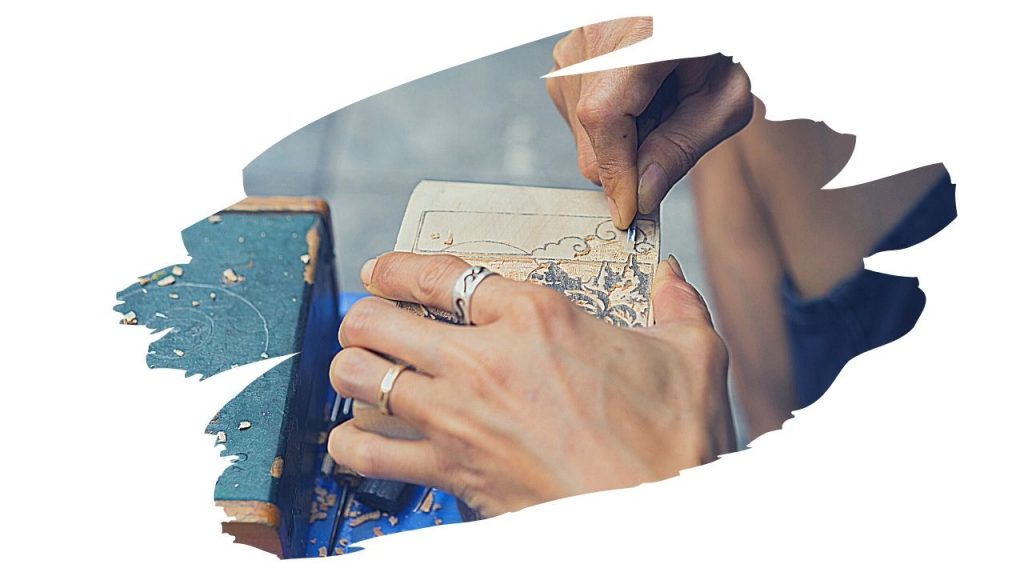There are many reasons why you might need to soften up a hard piece of wood.
Softening wood makes it more pliable and easier to carve into. Which is particularly important if you plan on using a less than pliable type of wood for whittling (and other similar wood carving styles).
In fact, we cover the differences between the most popular wood carving styles over here in our post: 11 Surprisingly Simple Wood Carving Projects for Absolute Beginners
And besides making wood easier to carve, softening wood also helps to limber up wood fibers, allowing woodworkers to easily steam-bend lumber.
So, if you’ve found that your wood block is too rigid for carving, you have a few options.
How to soften wood for carving (3 Main Ways):
- Soak or steam the wood with water.
- Spray the wood with rubbing alcohol.
- Steam the wood using a chemical agent (such as Ammonia).
Now, there’s obviously a little bit more to all of this than simply soaking lumber in a bathtub!
So lets take a deeper look into how we can go about softening up very dry and hard wood blocks...

This post may contain affiliate links to products that we receive a commission for (at no additional cost to you). Learn more here.
What Will Soften Wood?
If you want to make dry wood a bit more manageable, then you have four options; Water, Steam, Alcohol or Ammonia.
Quick Side-note: The ‘Steam’ and ‘Ammonia’ methods are typically used more for steam bending. And they are rarely used to help soften up a small wood boards for carving.
How Do I Make Wood Softer For Carving?
You have a variety of options, each with their own pro’s and cons:
Steaming with Water
Steaming wood involves exactly that, you steam the wood to help loosen up those fibers.
- Pros: This is one of the best ways to soften wood without it losing all of its shape – hence why it is the first choice for steam bending woodworkers.
- Cons: If you are not using straight grained wood, you can end up having problems with cracking and breakage.
What is straight grained wood? Straight grain refers to wooden boards that have fibers that run along the vertical axis of the tree log. Wood types such as Cedar, Cherry and Maple have straight grain.
Soak Wood In Water Before Carving
Another approach to softening up timber is to soak it in water. This is a quick way to add moisture back into dry wood. However, it won’t make the wood feel as pliable as freshly cut green wood.
Does soaking wood make it easier to carve? Yes it does. This is because as wood soaks the fiber grains in the wood become increasingly flexible as its cells start to absorb water.
- Pros: It’s cheap, and easy. And your whittling tools should be able to make quick head-way into the wood.
- Cons: Wood soaked in water tends to dry out really quickly. Which is not a good thing if you plan on using the wood for a more detailed and time-consuming carving project. Having to stop-start to re-soak the wood as you work can slow you down.
Wood cracking (also known as wood checking) is a frequent issue whenever you use water to soften up lumber. However, if you allow water-soaked wood to dry out very slowly, you may be able to prevent those cracks from appearing in the first place.
You can learn more about the hows and whys of this by checking out our post here: Will Linseed Oil Alone Be Enough To Stop Wood From Cracking?
How long should wood dry before carving? If you are dealing with freshly cut green wood, (and you’ve set the lumber aside in a cool dry place indoors), then give it about 6 weeks or so for it to dry. That’s the minimum amount of time you should wait to allow for its moisture content to fall to ‘carvable’ levels.
Use Wood Softening Chemical Agents
This approach involves applying an ammonia-based treatment to the wood. For example, using ammonia gas (instead of water steam) is often used in the process of softening wood for wood bending.
- Pros: Makes the wood much (much!) more pliable compared to using a water-only solution.
- Cons: It ruins the texture of wood fiber, making it look and feel too much like plastic. Plus, its a bit of an overkill approach if you simply want to use the wood for whittling or chip carving.
Try Using Alcohol To Soften Wood Instead
A home-made brew of 50% water and 50% rubbing alcohol can also do the trick.
Put the mixture into a clean spray bottle, and then spray the surface of the lumber.
- Pros: If you use straight rubbing alcohol, (i.e. absolutely no water added to the spray), then you won’t need to worry about water stains marring the wood surface.
- Cons: If you overdo it with the water/alcohol mixture, you could end up staining the wood with water marks.
Does Oil Soften Wood? Whilst oil can add a bit of color to blemish damaged surfaces, it does not work all that well as a softening agent.
Final Thoughts
As a general rule, it is much easier to carve into green wood. However if the wood you have to hand has no moisture left, and is very dry, you can still use it for your carving crafts.
You can easily make hard wood much softer by soaking it in water, or spraying its surface with isopropyl alcohol (otherwise known as rubbing alcohol).
This should be enough to soften up even the hardest of age-dried woods.



